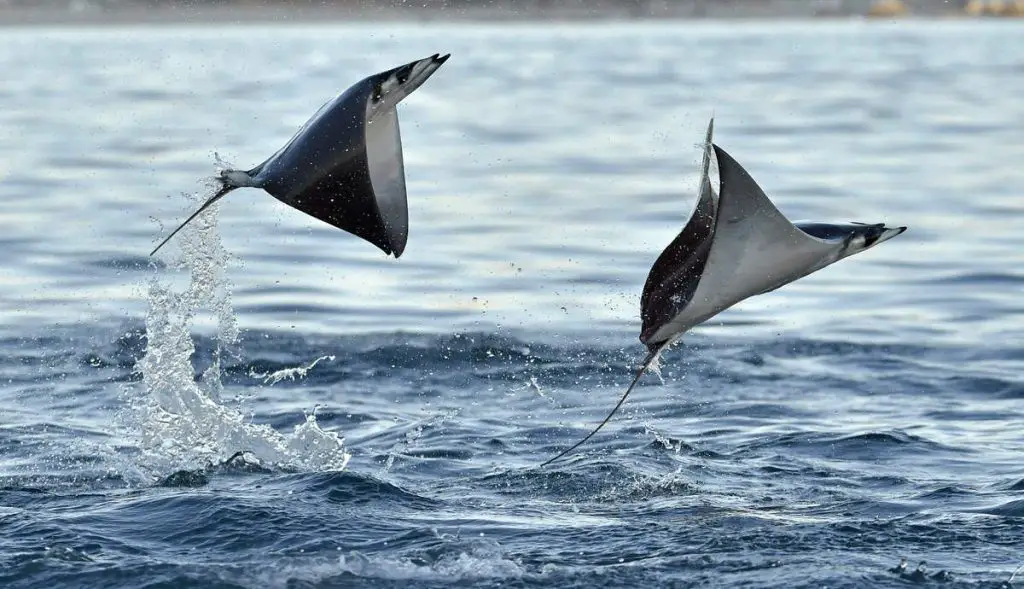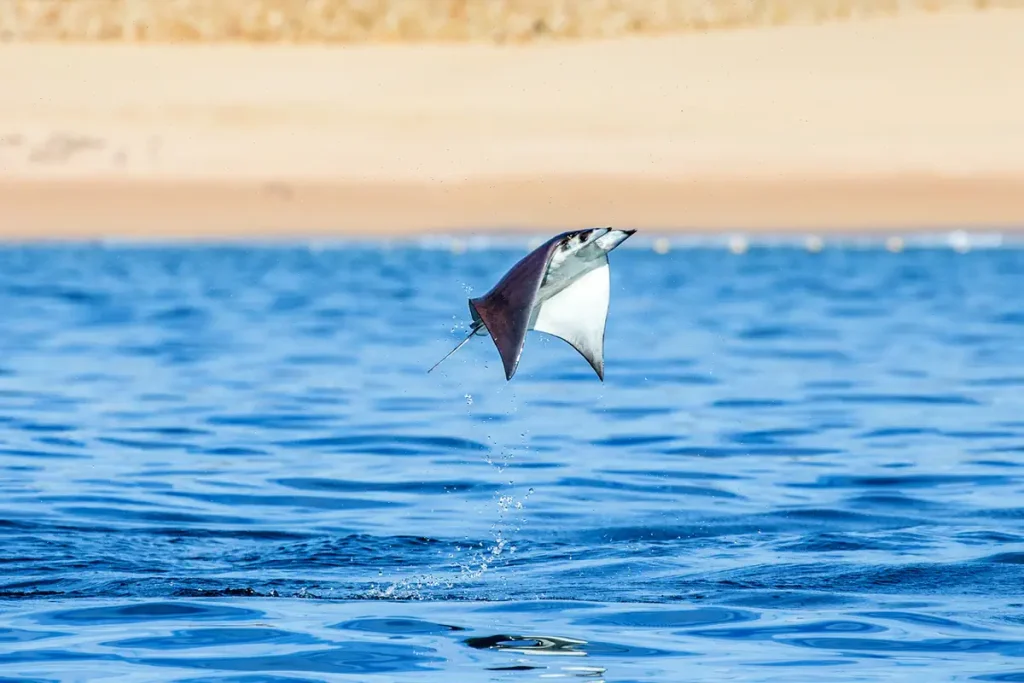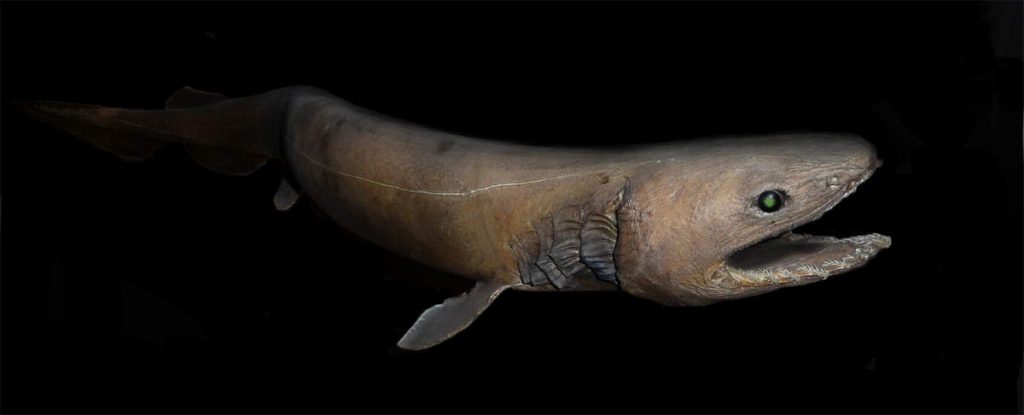Mobula is a genus of Batoidea, which is commonly known as rays. Mobula rays (scientific name: Mobula tarapacana) are also known as “flying mobula”, “flying rays”, “eagle rays”, or “devil rays”. Here are 10 amazing Mobula ray facts.
1. Mobula rays are huge
Their total width can be as large as 5.2 meters (17.1 feet). They are the second-largest rays after the Manta ray, which can reach a whopping 7 meters (23 feet) in width.
2. They can perform incredible surface acrobatics
It’s not uncommon for these amazing marine animals to perform incredible surface acrobatics. Mobula rays are able to leap out of the water, sometimes reaching heights of up to two meters. High jumps, twists, turns, and belly flops are all part of their show, as shown in the video below.
The purpose of this behavior is not fully understood, but it may be a form of communication or a way to escape predators.
Their large, flat, diamond-shaped bodies and long fins allow them to glide through the water – and also through the air.
Mobula rays in the Gulf of California (Sea of Cortés) have been reported to reach as high as 2 meters (6.5 feet) above the sea.
Here is an amazing video titled Gigantic School of Rays from National Geographic. A record-breaking school of Mobula rays has arrived off the coast of Baja California. They perform their characteristic acrobatics and flights over the sea surface.
In the video above, most Mobula rays are over 2 meters (6.5 feet) from tip to tip, as explained in the video.
3. They live in warm seas
Mobula rays can be found worldwide in tropical and warm temperate seas. They tend to prefer warmer waters and are often found in areas where there are high concentrations of plankton and other small organisms that they feed on. They are also known to undertake long migrations in search of food and may travel long distances between their feeding and breeding grounds.
4. Mobula rays are closely related to sharks!
Rays are closely related to sharks. Like sharks, rays are part of Chondrichthyes, a class that contains the cartilaginous fishes that have skeletons primarily composed of cartilage.
5. They create huge gatherings
Huge groups of these fish regularly gather together to leap out of the sea and launch themselves into the air. During the springtime, when the currents change and bring large sums of plankton and nutrients to the surface from the depths, the largest gathering of rays occurs.
During this time the schools can number in the tens of thousands of rays and be over a kilometer long!
6. Despite their common name “Devil Rays”, they are completely harmless
Mobula rays have cephalic fins, which are two frontal lobes that extend from the sides of their mouth and help funnel water and food into their mouth, just like their larger Manta ray cousins. But, unlike their cousins, the lobes of these Mobula rays do not unroll into flat fins. When viewed from above these modified fins look a bit like horns, which is where the nickname “Devil Ray” comes from. However, they have actually a very peaceful nature and are completely harmless.
Mobula rays are not considered dangerous to humans, as they are not aggressive and do not have venomous spines like some other types of rays.

7. They can perform extreme dives!
According to a 2014 study titled “Extreme diving behavior in devil rays links surface waters and the deep ocean” published in Nature, Scientists tagged 15 Chilean devil rays to track their movements. They discovered that while feeding, devil rays can dive to depths of nearly 2 kilometers (6,560 feet!) for around 60-90 minutes, at speeds of 13mph (22km/h).
This makes Mobula rays some of the deepest, fastest divers in the ocean.
8. They eat small marine animals
Mobula rays eat tiny fish and small, aquatic microorganisms called zooplankton.
They are filter feeders, which means that they consume small prey items that are suspended in the water. The exact composition of their diet can vary depending on the species of Mobula ray and the location where they are found.
In general, Mobula rays feed on a variety of planktonic organisms, including copepods, krill, and small fish such as anchovies and sardines. They use their wide, flattened mouths to scoop up water and filter out these tiny prey items using specialized structures called gill rakers.
Mobula rays have a high metabolic rate and need to consume a large amount of food in order to maintain their energy levels. Some species of Mobula ray are known to undertake long migrations in search of food, traveling to areas where there are high concentrations of plankton and other small organisms.
Although Mobula rays are primarily filter feeders, they have been known to engage in opportunistic feeding behavior as well. For example, they may feed on small fish that are attracted to fishing boats or feed on other prey items that are concentrated in specific areas. However, such behavior is thought to be relatively rare, and Mobula rays are not considered to be a significant predator of other marine species.
9. Their main predator in nature is Orca
Their main predator in nature is the Orca (killer whale). The orcas have been observed preying on more than 140 species of animals, including at least 50 species of marine mammals, and many species of bony fish, sharks, and rays. Luckily for us, orcas do not harm humans in the wild.
10. Females of mobula rays develop and hatch their eggs inside their body
Mobula rays are ovoviviparous: during reproduction, females develop and hatch their eggs inside their bodies before giving birth.
It is estimated that they give birth to only one pup (in some rare cases, two) every 3-5 years.
Their pregnancy period is very long. In some species, such as the giant devil ray, the pregnancy period can be as long as over two years!

Conversation status: Mobula Rays are near-threatened
Their conservation status has been labeled as Near-Threatened on the IUCN red list since 2006 (The Red List of Threatened Species, founded in 1964, is the world’s most comprehensive inventory of the global conservation status of biological species. It uses a set of criteria to evaluate the extinction risk of thousands of species and subspecies).
Most Batoidea species live on the seafloor, in a variety of geographical regions – many in coastal waters, few live in deep waters to at least 3,000 meters (9,800 feet), most batoids have a somewhat cosmopolitan distribution, in tropical and subtropical marine environments, temperate or cold-water species. Only a few species, like manta rays, live in the open sea, and only a few live in freshwater.
There is still plenty that experts don’t know about the family, including details of their evolutionary history and population structures. They tend to be shy and avoid people, so studying them can be difficult.
Sources
- Mobula on Wikipedia
- 9 Facts About Devil Rays on PADI.com
- Mobula Ray on National Geographic Kids website
- “The spectacular display of the Mobula ray” on the Natural History Museum website
- “The Magnificent Mobula Rays of Baja California, Mexico” on the Dive Ninja Expeditions website
- How Many Elephants are Left in the World in 2025? - August 17, 2025
- Moon Landings: All-Time List [1966-2025] - February 2, 2025
- What Is Max-Q and Why Is It Important During Rocket Launches? - January 16, 2025

